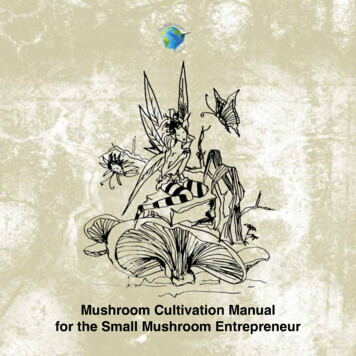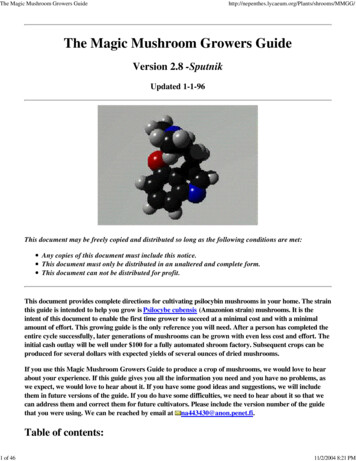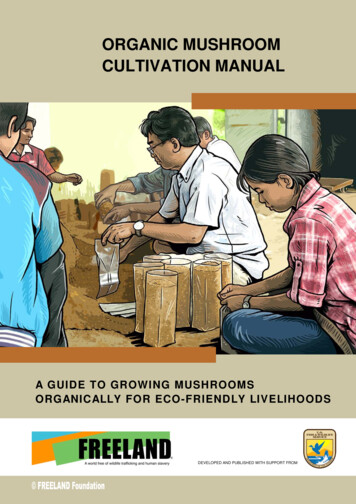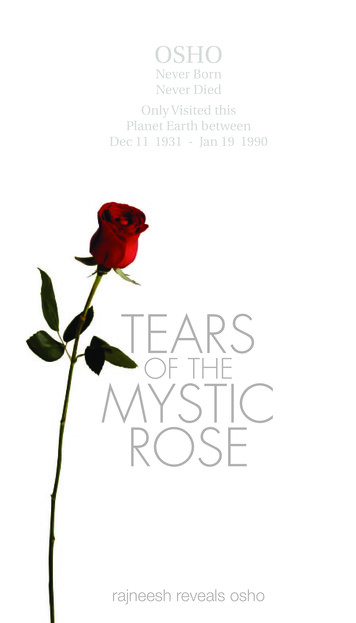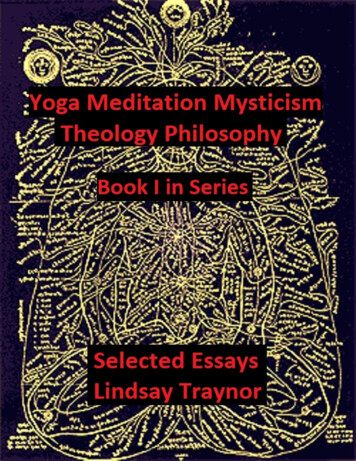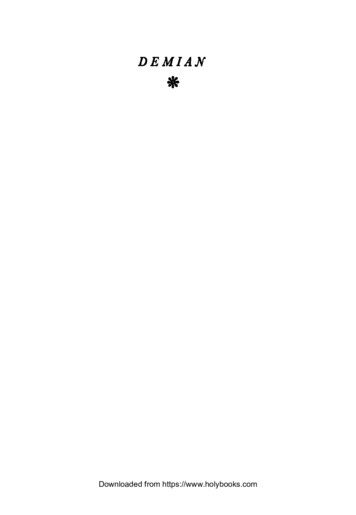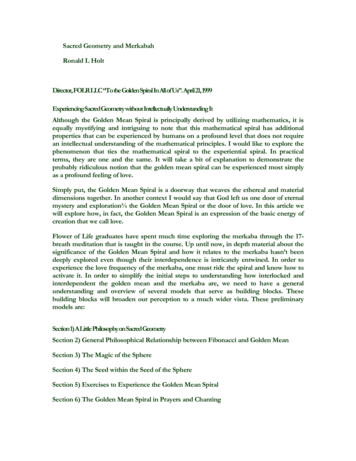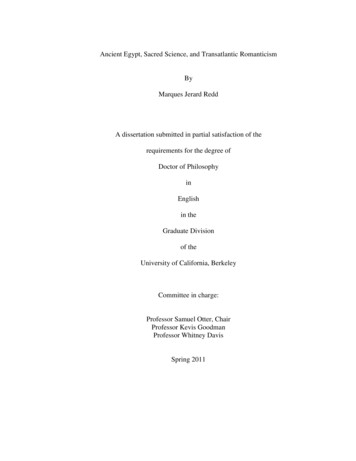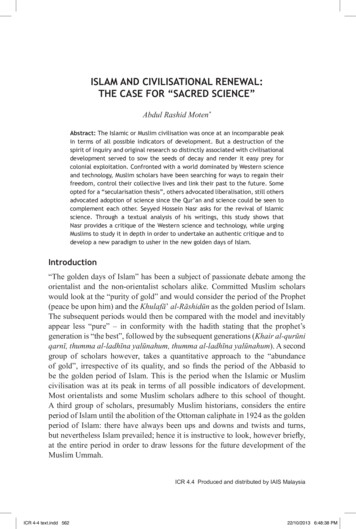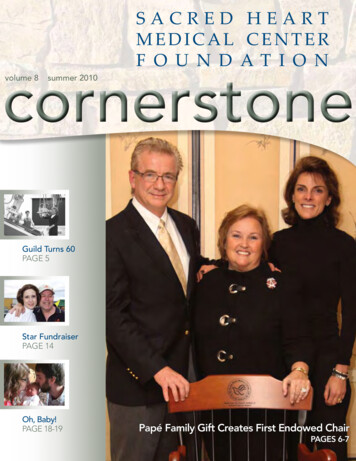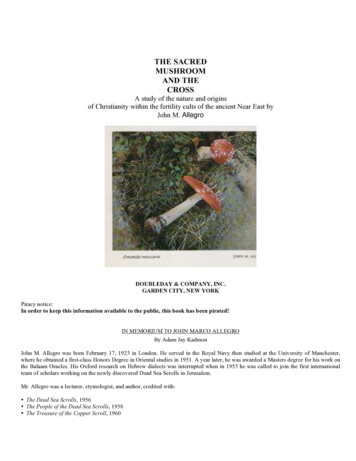
Transcription
THE SACREDMUSHROOMAND THECROSSA study of the nature and originsof Christianity within the fertility cults of the ancient Near East byJohn M. AllegroDOUBLEDAY & COMPANY, INC.GARDEN CITY, NEW YORKPiracy notice:In order to keep this information available to the public, this book has been pirated!IN MEMORIUM TO JOHN MARCO ALLEGROBy Adam Jay KadmonJohn M. Allegro was born February 17, 1923 in London. He served in the Royal Navy then studied at the University of Manchester,where he obtained a first-class Honors Degree in Oriental studies in 1951. A year later, he was awarded a Masters degree for his work onthe Balaam Oracles. His Oxford research on Hebrew dialects was interrupted when in 1953 he was called to join the first internationalteam of scholars working on the newly discovered Dead Sea Scrolls in Jerusalem.Mr. Allegro was a lecturer, etymologist, and author, credited with: The Dead Sea Scrolls, 1956 The People of the Dead Sea Scrolls, 1958 The Treasure of the Copper Scroll, 1960
The Shapira Affair, 1965Search in the Desert, 1967Discoveries in the Judaean Desert of Jordan, Qumrân Cave 4. V (4Q158-4Q186), 1968The Sacred Mushroom and the Cross, 1970The End of a Road, 1970The Chosen People, 1971Lost Gods, 1977The Dead Sea Scrolls and the Christian Myth, 1979All Manner of Men, 1982Physician, Heal Thyself, 1985John Marco Allegro died suddenly of an aortic aneurysm on his 65th birthday, February 17, 1988 at his home in Sandbach, Cheshire.Before his death, Allegro had been criticized by his former friends and colleagues for his outspoken and unconventional ideas. But farfrom being banished as a scholar after years of “academic” attack, he resigned from the University out of his own accord. He did thisbefore The Sacred Mushroom and the Cross went to print. He had had enough of academia and wanted to write freelance.I believe we lost a modern day “hero” in linguistics, etymology, philology, theology, mycology and much more,when we lost John Marco Allegro.ORIGINAL CHARACTERS OF SUMERIAN CUNEIFORM AND OTHER HIEROGLIPHIC CHARACTERS WERE LOSTBY THE CHARACTER RECOGNITION SOFTWARE USED IN THE PIRACY OF THIS BOOK. PLEASE SEEK ANORIGINAL COPY OF “THE SACRED MUSHROOM AND THE CROSS” TO REFERENCE MISSING LETTERS ANDOTHER POSIBLE ERRORS MADE BY THE RECOGNITION SOFTWARE.150 pages of reference notes at the back of the book have been omitted. Footnote numbers have (for the most part) been leftintact. Some Zeros (0) and ones (1) were not recognized.Primary errors made by Allegro are HIGHLIGHTED IN REDAllegro did NOT understand the growth cycle, effects and "bitterness" of the Amanita muscaria. Allegro overlooked some references toboth A. pantherina and P. cubensis, and wrongfully classified Rue as an "abortifacient", not recognizing Acacia and Rue as anAyahuasca analogue. Allegro also wrongfully assumed that the mushrooms, and not religion and government themselves, were the causeof the shaman to protest against their suppression by the churches and governments. With that said, Allegro was a pioneer in the field ofethnomycology, and founded many of the ideas many researchers use today (though most deny it).Enjoy your read!Author’s NoteThis book is the first published statement of the fruits of some years’ work of a largely philological nature. It presents a new appreciationof the relationship of the languages of the ancient world and the implication of this advance for our understanding of the Bible and of theorigins of Christianity. It will be appreciated that such a statement has to be furnished with the technical data, even though much of itmust be outside the scope of the general reader, for whom the book is primarily intended. In order to leave the text as unencumbered aspossible, these notes have been gathered in a body at the end of the book, and the numbered references within the text may be safelyignored by the non-specialist.AcknowledgementsQuotations from the Revised Standard Version of the Bible, copyrighted 1952 and 1956, are used by permission.Quotations from the Homeric Hymns, Pliny’s Natural History, andJosephus’ Jewish Wars and Antiquities are used by permission of theLoeb Classical Library.
The frontispiece photograph is used by permission of Rex Lowden.The photograph facing page 74 is used by permission of PhotographeThuillier.ContentsIntroduction page xiI In the Beginning God Created. iII Sumer and the Beginnings of History 8III The Names of the Gods 19IV Plants and Drugs 29V Plant Names and the Mysteries of the Fungus 36VI The Key of the Kingdom 44VII The Man-child Born of a Virgin 54VIII Woman’s part in the Creative Process 63IX The Sacred Prostitute 76X Religious Lamentation 83XI The Mushroom “Egg” and Birds of Mythology 91XII The Heavenly Twins 97XIII Star of the Morning 109XIV Colour and Consistency 118XV Mushroom Cosmography 133XVI David, Egypt, and the Census 141XVII Death and Resurrection 151XVIII The Garden of Adonis, Eden and Delight;Zealots and Mus1im 177XIX The Bible as a Book of Morals 191Notes 207Indices 308Figurespage1 The Near East2 Sumer and Accad 103 Section through the calyx and fruit of Henbane 584 Diagrammatic section of (i) a volva before “birth” 92(ii) a mature mushroom 925 Zion, and the valleys of Kidron and Hinnom 1366 Jerusalem to the Dead Sea 138IntroductionNo one religion in the ancient Near East can be studied in isolation. All stem from man’s first questioning about the origin of life andhow to ensure his own survival. He has always been acutely conscious of his insufficiency. However much he progressed technically,making clothes, shelter, conserving food and water supplies, and so on, the forces of nature were always greater than he. The windswould blow away his shelter, the sun parch his crops, wild beasts prey on his animals: he was always on the defensive in a losing battle.Out of this sense of dependency and frustration, religion was born.Somehow man had to establish communications with the source of the world’s fertility, and thereafter maintain a right relationship withit. Over the course of time he built up a body of experiential knowledge of rituals that he or his representatives could perform, or wordsto recite, which were reckoned to have the greatest influence on this fertility deity. At first they were largely imitative. If rain in thedesert lands was the source of life, then the moisture from heaven must be only a more abundant kind of spermatozoa. If the male organejaculated this precious fluid and made life in the woman, then above the skies the source of nature’s semen must be a mighty penis, asthe earth which bore its offspring was the womb. It followed therefore that to induce the heavenly phallus to complete its orgasm, manmust stimulate it by sexual means, by singing, dancing, orgiastic displays and, above all, by the performance of the copulatory act itself:
However &r man progressed in his control of the world about him there remained a large gap between what he wanted at any one timeand what he could achieve on his own account. There was always some unscalable mountain, some branch of knowledge whichremained unpenetrable, some disease with no known cure. It seemed to him that if he had managed painstakingly to grope his way to aknowledge and dexterity so far above the animals, then in some mysterious way his thinkers and artisans must have been tapping asource of wisdom no less real than the rain that fructified the ground. The heavenly penis, then, was not only the source of life-givingsemen, it was the origin of knowledge. The seed of God was the Word of God.The dream of man is to become God. Then he would be omnipotent; no longer fearful of the snows in winter or the sun in summer, orthe drought that killed his cattle and made his children’s bellies swell grotesquely. The penis in the skies would rise and spurt its vitaljuice when man commanded, and the earth below would open its vulva and gestate its young as man required. Above all, man wouldlearn the secrets of the universe not piecemeal, painfully by trial and fatal error, but by a sudden, wonderful illumination from within.But God is jealous of his power and his knowledge. He brooks no rivals in heavenly places. If, in his mercy, he will allow just a veryfew of his chosen mortals to share his divinity, it is but for a fleeting moment. Under very special circumstances he will permit men torise to the throne of heaven and glimpse the beauty and the glory of omniscience and omnipotence. For those who are so privileged therehas seemed no greater or more worthwhile experience. The colours are brighter, the sounds more penetrating, every sensation ismagnified, every natural force exaggerated.For such a glimpse of heaven men have died. In the pursuit of this goal great religions have been born, shone as a beacon to menstruggling still in their unequal battle with nature, and then too have died, stifled by their own attempts to perpetuate, codify, andevangelize the mystic vision.Our present concern is to show that Judaism and Christianity are such cultic expressions of this endless pursuit by man to discoverinstant power and knowledge. Granted the first proposition that the vital forces of nature are controlled by an extra—terrestrialintelligence, these religions are logical developments from the older, cruder fertility cults. With the advance of technical proficiency theaims of religious ritual became less to influence the weather and the crops than to attain wisdom and the knowledge of the future. TheWord that seeped through the labia of the earth’s womb became to the mystic of less importance than the Logos which he believed hisreligion enabled him to apprehend and enthuse him with divine omniscience. But the source was the same vital power of the universeand the cultic practice differed little.To raise the crops the farmer copulated with his wife in the fields. To seek the drug that would send his soul winging to the seventhheaven and back, the initiates into the religious mysteries had their priestesses seduce the god and draw him into their grasp as a womanfascinates her partner’s penis to erection.For the way to God and the fleeting view of heaven was through plants more plentifully endued with the sperm of God than any other.These were the drug-herbs, the science of whose cultivation and use had been accumulated over centuries of observation and dangerousexperiment. Those who had this secret wisdom of the plants were the chosen of their god; to them alone had he vouchsafed the privilegeof access to the heavenly throne. And if he was jealous of his power, no less were those who served him in the cultic mysteries. Theirswas no gospel to be shouted from the rooftops: Paradise was for none but the favoured few. The incantations and rites by which theyconjured forth their drug plants, and the details of the bodily and mental preparations undergone before they could ingest their god, werethe secrets of the cult to which none but the initiate bound by fearful oaths, had access.Very rarely, and then only for urgent practical purposes, were those secrets ever committed to writing. Normally they would be passedfrom the priest to the initiate by word of mouth; dependent for their accurate transmission on the trained memories of men dedicated tothe learning and recitation of their “scriptures”. But if for some drastic reason like the disruption of their cultic centres by war orpersecution, it became necessary to write down the precious names of the herbs and the manner of their use and accompanyingincantations, it would be in some esoteric form comprehensible only to those within their dispersed communities.Such an occasion, we believe, was the Jewish Revolt of Al) 66. Instigated probably by members of the cult, swayed by their drug-
induced madness to believe God ad called them to master the world in his name, they provoked the mighty power of Rome to swift andterrible action. Jerusalem was ravaged, her temple destroyed. Judaism was disrupted, and her people driven to seek refuge withcommunities already established around the Mediterranean coastlands. The mystery cults found themselves without their central fount ofauthority, with many of their priests killed in the abortive rebellion or driven into the desert. The secrets, if they were not to be lost forever, had to be committed to writing, and yet, if found, the documents must give nothing away or betray those who still dared defy theRoman authorities and continue their religious practices.The means of conveying the information were at hand, and had been for thousands of years. The folk-tales of the ancients had from theearliest times contained myths based upon the personification of plants and trees. They were invested with human faculties and qualitiesand their names and physical characteristics were applied to the heroes and heroines of the stories. Some of these were just tales spun forentertainment, others were political parables like Jotham’s fable about the trees in the Old Testament, while others were means ofremembering and transmitting therapeutic folk-lore. The names of the plants were spun out to make the basis of the stories, whereby thecreatures of fantasy were identified, dressed, and made to enact their parts. Here, then, was the literary device to spread occultknowledge to the faithful. To tell the story of a rabbi called Jesus, and invest him with the power and names of the magic drug. To havehim live before the terrible events that had disrupted their lives, to preach a love between men, extending even to the hated Romans.Thus, reading such a tale, should it fall into Roman hands, even their mortal enemies might be deceived and not probe farther into theactivities of the cells of the mystery cults within their territories.The ruse failed. Christians, hated and despised, were hauled forth and slain in their thousands. The cult well nigh perished. Whateventually took its place was a travesty of the real thing, a mockery of the power that could raise men to heaven and give them theglimpse of God for which they gladly died. The story of the rabbi crucified at the instigation of the Jews became an historical peg uponwhich the new cult’s authority was founded. What began as a hoax, became a trap even to those who believed themselves to be thespiritual heirs of the mystery religion and took to themselves the name of “Christian”. Above all they forgot, or purged from the cult andtheir memories, the one supreme secret on which their whole religious and ecstatic experience depended:the names and identity of the source of the drug, the key to heaven — the sacred mushroom.The fungus recognized today as the Amanita muscaria, or Fly—Agaric, had been known from the beginning of history. Beneath the skinof its characteristic red— and white-spotted cap, there is concealed a powerful hallucinatory poison. Its religious use among certainSiberian peoples and others has been the subject of study in recent years, and its exhilarating and depressive effects have been clinicallyexamined. These include the stimulation of the perceptive faculties so that the subject sees objects much greater or much smaller thanthey really are, colours and sounds are much enhanced, and there is a general sense of power, both physical and mental quite outside thenormal range of human experience.The mushroom has always been a thing of mystery. The ancients were puzzled by its manner of growth without seed, the speed withwhich it made its appearance after rain, and its as rapid disappearance. Born from a volva or “egg” it appears like a small penis, raisingitself like the human organ sexually aroused, and when it spread wide its canopy the old botanists saw it as a phallus bearing the“burden” of a woman’s groin. Every aspect of the mushroom’s existence was fraught with sexual allusions, and in its phallic form theancients saw a replica of the fertility god himself. It was the “son of God”, its drug was a purer form of the god’s own spermatozoa thanthat discoverable in any other form of living matter. It was, in fact, God himself, manifest on earth. To the mystic it was the divinelygiven means of entering heaven; God had come down in the flesh to show the way to himself, by himself to pluck such a precious herbwas attended at every point with peril. The time — before sunrise, the words to be uttered — the name of the guardian angel, were vitalto the operation, but more was needed. Some form of substitution was necessary, to make an atonement to the earth robbed of heroffspring. Yet such was the divine nature of the Holy Plant, as it was called, only the god could make the necessary sacrifice. To redeemthe Son, the Father had to supply even the “price of redemption”. These are all phrases used of the sacred mushroom, as they are ofthe Jesus of Christian theology.Our present study has much to do with names and titles. Only when we can discover the nomenclature of the sacred fungus within andwithout the cult, can we begin to understand its function and theology. The main factor that has made these new discoveries possible hasbeen the realization that many of the most secret names of the mushroom go back to ancient Sumerian, the oldest written languageknown to us, witnessed by cuneiform texts dating from the fourth millennium BC. Furthermore, it now appears that this ancient tongue
provides a bridge between the Indo-European languages (which include Greek, Latin, and our own tongue) and the Semitic group, whichincludes the languages of the Old Testament, Hebrew and Aramaic. For the first time, it becomes possible to decipher the names of gods,mythological characters, classical and biblical, and plant names. Thus their place in the cubic systems and their functions in the oldfertility religions can be determined.The great barriers that have hitherto seemed to divide the ancient world, classical and biblical, have at last been crossed and at a moresignificant level than has previously been possible by merely comparing their respective mythologies. Stories and characters which seemquite different in the way they are presented in various locations and at widely separated points in history can now be shown often tohave the same central theme. Even gods as different as Zeus and Yahweh embody the same fundamental conception of the fertility deity,for their names in origin are precisely the same. A common tongue overrides physical and racial boundaries. Even languages soapparently different as Greek and Hebrew, when they can be shown to derive from a common fount, point to a communality of culture atsome early stage. Comparisons can therefore be made on a scientific, philological level which might have appeared unthinkable beforenow. Suddenly, almost overnight, the ancient world has shrunk. All roads in the Near East lead back to the Mesopotamian basin, toancient Sumer. Similarly, the most important of the religions and mythologies of that area, and probably far beyond, are reaching back tothe mushroom cult of Sumer and her successors.In biblical studies, the old divisions between Old and New Testament areas of research, never very meaningful except to the Christiantheologian, become even less valid. As far as the origins of Christianity are concerned, we must look not just to intertestamentalliterature, the Apocrypha and Pseudepigrapha, and the newly discovered writings from the Dead Sea, nor even merely to the OldTestament and other Semitic works, but we have to bring into consideration Sumerian religious and mythological texts and the classicalwritings of Asia Minor, Greece, and Rome. The Christian Easter is as firmly linked to the Bacchic Anthesteria as the Jewish Passover.Above all, it is the philologian who must be the spearhead of the new enquiry. It is primarily a study in words.A written word is more than a symbol: it is an expression of an idea. To penetrate to its inner meaning is to look into the mind of theman who wrote it. Later generations may give different meanings to that symbol, extending its range of reference far beyond the originalintention, but if we can trace the original significance then it should be possible to follow the trail by which it developed. In doing so, itis sometimes possible even to outline the progress of man’s mental, technical or religious development.The earliest writing was by means of pictures, crudely incised diagrams on stone and clay. However lacking such symbols may be ingrammatical or syntactical refinement, they do convey, in an instant, the one feature which seemed to the ancient scribe the mostsignificant aspect of the object or action he is trying to represent. “Love” he shows as a flaming torch m a womb, a foreign country as ahill (because he lived on a plain), and so on. As the art of writing developed further, we can begin to recognize the first statements ofideas which came later to have tremendous philosophical importance, “life”, “god”, “priest”, “temple”, “grace”, “sin”, and so on. Toseek their later meanings in religious literature like the Bible we must first discover their basic meaning and follow their developmentthrough as far as extant writings will allow.For example, as we may now understand, “sin” for Jew and Christian had to do with the emission to waste of human sperm, a blasphemyagainst the god who was identified with the precious liquid. If to discover this understanding of “sin” seems today of only limitedacademic interest, it is worth recalling that it is this same principle that lies at the root of modern Catholic strictures against the use of the“Pill”.As far as the main burden of our present enquiry is concerned, our new-found ability to penetrate to the beginnings of language meansthat we can set the later mystery cults, as those of Judaism, of the Dionysiac religion and Christianity, into their much wider context, todiscover the first principles from which they developed, probe the mysteries of their cultic names and invocations, and, in the case ofChristianity at least, appreciate something of the opposition they encountered among governing authorities and the measures taken totransmit their secrets under cover of ancient mythologies in modern dress.Our study, then, begins at the beginning, with an appreciation of religion in terms of a stimulation of the god to procreation and the
provision of life. Armed with our new understanding of the language relationships of the ancient Near East, we can tackle the majorproblems involved in botanical nomenclature and discover those features of the more god-endued plants which attracted the attention ofthe old medicine men and prophets. The isolation of the names and epithets of the sacred mushroom opens the door into the secretchambers of the mystery cults which depended for their mystic hallucinatory experiences on the drugs found in the fungus. At long lastidentification of the main characters of many of the old classical and biblical mythologies is possible, since we can now decipher theirnames. Above all, those mushroom epithets and holy invocations that the Christian cryptographers wove into their stories of the manJesus and his companions can now be recognized, and the main features of the Christian cult laid bare.The isolation of the mushroom cult and the real, hidden meaning of the New Testament writings drives a wedge between the moralteachings of the Gospels and their quite amoral religious setting. The new discoveries must thus raise more acutely the question of thevalidity of Christian “ethics” for the present time. If the Jewish rabbi to whom they have hitherto been attributed turns out to have beenno more substantial than the mushroom, the authority of his homilies must stand or fall on the assent they can command on their ownmerit.What follows in this book is, as has been said, primarily a study in words. To a reader brought up to believe in the essential historicity ofthe Bible narratives some of the attitudes displayed in our approach to the texts may seem at first strange. We appear to be moreinterested with the words than with the events they seem to record; more concerned, say, in the meaning of Moses’ name than hissupposed role as Israel’s first great political leader. Similarly, a century or so ago, it must have seemed strange to the average Biblestudent to understand the approach of a “modernist” of the day who was more interested in the ideas underlying the Creation story ofGenesis and their sources, than to date, locate, and identify the real Garden of Eden, and to solve the problem of whence came Cain’swife. Then, it took a revolution in man’s appreciation of his development from lower forms of life and a clearer understanding of the ageof this planet to force the theologian to abandon the historicity of Genesis.Now we face a new revolution in thought which must make us reconsider the validity of the New Testament story. The break-throughhere is not in the field of history but in philology. Our fresh doubts about the historicity of Jesus and his friends stem not from newdiscoveries about the land and people of Palestine of the first century, but about the nature and origin of the languages they spoke andthe origins of their religious cults. What the student of Christian origins is primarily concerned with is, what manner of writing is thisbook we call the New Testament, and in particular just what are the narratives called the Gospels trying to convey? Is it history? This iscertainly a possibility, but only one of many. The fact that for nearly two thousand years one religious body has pinned its faith upon notonly the existence of the man Jesus, but even upon his spiritual nature and the historicity of certain unnatural events called miracles, isnot really relevant to the enquiry. A hundred years ago this same body of opinion was equally adamant that the whole of the human racecould trace its origin to two people living in the middle of Mesopotamia, and that the earth had come into existence in the year 4004 BC.The enquirer has to begin with his only real source of knowledge, the written word. As far as Judaism and Christianity are concerned,this means the Bible. There is precious little else that can give us details about what the Israelite believed about his god and the worldabout him, or about the real nature of Christianity. The sparse references to one “Christus” or “Chrestus” in the works of contemporarynon-Christian historians, tell us nothing about the nature of the man, and only very dubiously, despite the claims often made for them, dothey support his historicity. They simply bear witness to the fact, never in dispute, that the stories of the Gospels were in circulation soonafter AD 70. If we want to know more about early Christianity we must look to our only real source, the written words of the NewTestament. Thus, as we have said, the enquiry is primarily philological.The New Testament is full of problems. They confront the critical enquirer on every side: chronological, topographical, historical,religious, and philological. It is not until the language problems have been resolved that the rest can be realistically appraised. When, inthe last century, a mass of papyrological material became available from the ancient world and cast new light upon the nature of theGreek used in the New Testament, scholars felt that most of the major obstacles to a complete understanding of the texts would beremoved. But, in fact, to the philologian the thorny questions remain firmly embedded in the stories, and they have nothing to do withthe plot of the narratives, or the day-to-day details which add colour to the action. The most intransigent concern the foreign, presumedAramaic transliterations in the text, coupled often with a “translation” which does not seem to offer a rendering of the original, like thenickname “Boanerges”, supposed to mean, “Sons of Thunder”, or the name “Barnabas”, said to represent “Son of Consolation”. Try asthey will, the commentators cannot see how the “translations” fit the “names”.
To the general reader, and particularly to the Christian seeking moral or spiritual enlightenment from the New Testament, such triviahave meant little. To many scholars, too, details like these are of less importance than the theological import of Jesus’ teaching. It hasbeen assumed that somewhere along the line of transmission some textual corruption occurred in the “names”, or that the “translations”were added by later hands unfamiliar with the original language used by the Master and his companions.As we can now appreciate, these aberrations of the proper names and their pseudo—translations are of crucial importance. They provideus with a clue to the nature of original Christianity. Concealed within are secret names for the sacred fungus, the sect’s “Christ”. Thedeliberately deceptive nature of their mistranslations put the lie to the whole of the “cover—story” of the man Jesus and his activities.Once the ruse is penetrated, then research can go ahead fast with fitting the Christian phenomenon more firmly into the cultic patterns ofthe ancient Near East. Many apparently quite unrelated facts about the ubiquitous mystery cults of the area and their related mythologiessuddenly begin to come together into an intellectually satisfying whole.In any study of the sources and development of a particular religion, ideas are the vital factor. History takes second place. Even time isrelatively unimportant. This is not to underestimate the importance of political and sociological influences in the fashioning of a cult andits ideology; but the prime materials of the philosophy stem from a fundamental conception of the universe and the source of life.Certain highly imaginative or “inspired” men may appear from time to time in a people’s history and affect the beliefs and manner oflife of their. contemporaries and successors. They adapt or develop what they find and give it a new impetus or direction. But the claythey are
The Shapira Affair, 1965 Search in the Desert, 1967 Discoveries in the Judaean Desert of Jordan, Qumrân Cave 4. V (4Q158-4Q186), 1968 The Sacred Mushroom and the Cross, 1970 The End of a Road, 1970 The Chosen People, 1971 Lost Gods, 1977 The Dead Sea Scrolls and the Christian Myth, 1979
